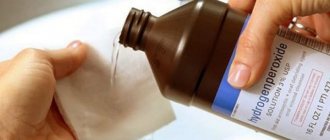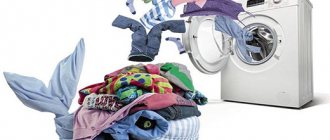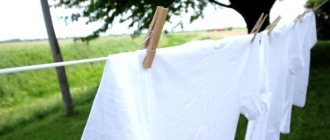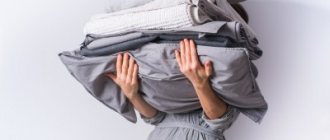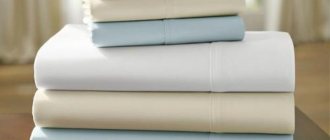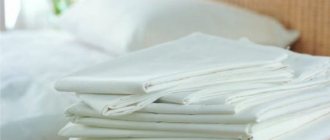Bedroom - This is the part of the house that only the owners of the house see. But even in such a secluded corner, everything should be impeccable - from the wallpaper on the walls to the linens on the bed. Over time, light-colored fabrics fade, acquire a gray or yellow tint, and become covered with old stains. Detergents and folk remedies will help restore bedding to its former freshness.
We return the whiteness to yellowed laundry
After many washes, light-colored fabric can acquire a gray, yellow, or light green tint. There are several reasons for this negative impact:
- Washing water with a high iron content (more than 7 degrees of hardness), nitrates.
- The use of washing powders, stain removers with a high content of phosphates, flatates, and hydrochloric acid.
- Regularly wash light-colored bed linen with dark-colored items.
Folk methods that use gentle detergents will help restore a presentable appearance to products. In addition to the loss of natural shine and color, stains of various origins appear on the fabric.
Why do white things turn yellow and gray?
There are several reasons why linen loses its color, becomes unpleasantly yellow, fades or turns gray:
- washing too often;
- wash together with colored items;
- non-compliance with the washing and ironing regime;
- reaction of washing powder to salts contained in hard water;
- long-term storage of things in a dirty or damp state.
Accordingly, the principles of preserving the whiteness of things are careful wearing, sorting clothes before washing into white and colored ones, as well as storing clothes only in a dry and clean state.
Knowledge of whitening methods will definitely be useful to any housewife. These methods will cope with the consequences of frequent washing in hard water and eliminate the most common stains on clothes:
- food stains: the most difficult to remove are greasy stains, stains from vegetables and fruits;
- stains from pharmaceuticals - solutions of brilliant green, iodine, manganese, etc.;
- stains from cosmetic products - foundation, powder, mascara, nail polish, nail polish remover, which housewives often use to remove such stains;
- stains left by animals.
The first thing housewives turn to when they take out a gray item with lingering stains from the washing machine are various chemicals to restore the whiteness of their laundry.
Linen with stains
Regular care is not enough to cleanse fabric from dirt. Stains must be treated before washing. Modern housewives use synthetic stain removers, but folk recipes can be an excellent alternative. Stains of various origins are removed by the following means:
- Gasoline – oil-salt contamination.
- Turpentine - oil paints, birch tar.
- Kerosene – traces of vegetable oil, products based on it (sprats, fried foods).
- Vinegar – stains from fish oil, rust.
- Ammonia - traces of egg yolks, whites, chocolate, brewed coffee.
- Soap solution - blood stains, traces of sweat.
It is recommended to first dry greasy marks with an iron - place a clean cloth on the stain and run the heated device several times. After using each product, the product must be washed and rinsed thoroughly.
Selecting a machine wash mode
To choose the right machine wash mode, you need to focus on the material from which the laundry is made:
- Cotton and linen. Suitable temperature 60 °C. Permissible temperature (for children's bedding) is 90°C. You can set the spin to the maximum number of revolutions. It is better not to use automatic drying. Dry laundry out of direct sunlight.
- Synthetic materials. “Delicate” mode. Temperature 40°C. Automatic drying is not recommended.
- Silk. Maximum temperature 30°C. Drying and spinning are prohibited. For washing, use liquid powder, conditioner and water softener.
- Poplin. Washable just like cotton. Temperature 40–60 °C.
- Satin. Temperature 60°C, if the powder is liquid – 40°C. Maximum spin.
- Batiste and bamboo. “Delicate” mode. Average spin. Temperature up to 40°C.
Choose the temperature mode based on the product label.
How often should you wash your clothes? Ideally, sheets and pillowcases should be changed once a week, duvet covers - once every 2 weeks.
Special industrial bleaching agents (some recommendations)
The easiest way to whiten yellowed sheets, duvet covers and pillowcases is to buy a stain remover at the store and wash the items in its solution. But, this method requires compliance with the rules:
- Before washing, you need to study the manufacturer's recommendations on the label: temperature, spin, warnings.
- You need to pre-soak your laundry separately from other items, especially colored ones.
- Chlorine-containing products are not suitable for cotton fabrics with embroidery - its aggressive components destroy natural fibers.
To achieve maximum whitening effect, you need to use products marked “for white”, which include: sodium perborate, fumaric acid, subtilisin.
The power of oxygen
At home, you can restore the whiteness of a grayed bedding set in another way. Oxygen bleaches are effective, safe, do not cause allergic reactions, suitable for cotton, synthetics, and delicate fabrics . Available in two forms: liquid and powder.
Oxygen bleaches are made from carbonate or carbonate peroxyhydrate. During the cycle, the active substance breaks down into soda, which has a bleaching effect, and peroxide, which releases oxygen. Due to the saturation of water with bubbles, contaminants are much better washed out of the fabric fibers.
Today, housewives prefer the following bleaches with active oxygen:
- Eco-Way Oxygen;
- Sarma Active;
- LionClean Plus;
- Antipyatin Oxi-formula;
- Spivak;
- Vanish Oxy;
- Greenfield Oxy Crystal;
- Persol Extra.
The main advantages of oxygen bleach:
- does not harm delicate fabrics;
- works even in lukewarm water;
- removes old, stubborn dirt;
- completely rinsed;
- extremely rarely causes allergic reactions.
As for the disadvantages, this is a decent cost of the product and quite a large expense. Although among oxygen bleaches you can find inexpensive packages. For example, Antipyatin with active oxygen costs about 65 rubles, and Persol - only 30 rubles.
Boiling
The procedure for boiling clothes, towels, and bed linen began to be used back in the 14th century in Europe, America and Rus'. The purpose of boiling products was not only hygienic cleaning of dirt, but also disinfection - the destruction of deadly viruses, bacteria, and infections. Today, this function is performed by professional preparations, and boiling is used as a way to eliminate yellowness. Recommendations for digestion:
For the procedure you will need a large container - a bowl, pan, boiling water.- The laundry must be placed in cold water with diluted detergent, and only then heated.
- You need to boil the wash for at least 2 hours, stirring regularly with a wooden object.
- After boiling, do not remove it from the container, but leave it in it until it cools.
To add shine and eliminate yellowness, add methylene blue solution (blue) to the water for rinsing boiled bed linen in the proportions of 5 drops per 10 liters. water.
Important! If you place dirty laundry in boiled water, the yellowness and stains will not disappear, but will penetrate even deeper into the fabric.
We bleach, starch and use blue
When using special bleach, we recommend that you do not skimp on the cleaning agent itself and water. It’s better to put smaller things, otherwise there won’t be a good result. You can avoid soaking and boiling in the following way.
We load the clothes into the machine, add powder, set the temperature to 30 degrees and completely turn off the spin cycle. At the end of the cycle, turn on the standard mode, not forgetting to add more washing powder. You can emphasize the snowy freshness by starching and bluing the fabric. We carry out these procedures during rinsing.
To starch fabric, pour a small amount of starch (from 1/4 teaspoon to 1 tablespoon, depending on the amount of work and the desired degree of hardness) into a glass, add water, stir and pour into the basin where you are going to rinse the item of clothing.
It should be rinsed, taken out of the water and wrapped in a towel. We dry the starched product in a straightened form - placing it on a towel or hanging it on a rope.
For bluing, use a small amount of blue or a couple of drops of brilliant green, which is added to a bowl of water for rinsing. After rinsing, twist and dry the product as usual.
No boiling
If there is no desire or opportunity, then you can turn yellowed items into snow-white ones using regular washing. They do this in the following sequence:
- Soak the products in hot water (60 degrees) for 2-10 hours.
- Before washing, remove the laundry from the water in which it was soaked and twist it.
- Prepare a solution for washing: 5 liters. warm water, take 200 ml of soap solution (dry or liquid stain remover).
- Place bedding in the solution and squeeze thoroughly for 5-10 minutes.
- Rinse the products 2-3 times (until the soap bubbles on the surface of the water disappear), add a few drops of blue to the last rinse.
This is the sequence for hand washing. Using a washing machine makes adjustments to this list: the first three points do not change, but instead of 4 and 5, the laundry wrung out after soaking is placed in the drum and the appropriate mode is selected.
Traditional methods to help whiten cotton underwear
There are many proven ways to wash white bras at home. Before washing, you should determine the type of fabric, since products made from cotton and those containing synthetics require a different approach. Folk recipes using simple and affordable means do a good job of bleaching and returning color to cotton items.
Boiling
The easiest way to bleach white bed linen, children's clothes and lingerie sets at home is by boiling. This method is suitable for returning color to cotton bras, but is not suitable for synthetic products. To wash white things, you need to pour water into a saucepan, bring it to a boil and add one of the suitable ingredients - soda, grated shavings of laundry soap, a few drops of the “Whiteness” product or a couple of drops of ammonia. A boiling container with a bleach solution is placed on low heat, the discolored white bras and swimming trunks are lowered and boiled for half an hour. Then the items are allowed to cool and rinsed in warm water. The method works well to bleach darkened and yellow-stained items at home, but it leads to increased humidity in the room.
Laundry soap
A soap solution made from laundry soap has excellent whitening properties. This product helps restore whiteness to cotton bras, as well as those made from dense natural materials, but it’s better not to take risks when washing lace underwear. To remove yellowness and gray plaque, prepare a soap solution and then wash it by hand.
It is very important to rinse the white bra well, otherwise streaks may appear after drying.
Household bleaches
Ready-made household chemicals are often used to bleach cotton laundry. There are chlorine and oxygen types of bleaches. The former have a negative quality, which consists in the gradual destruction of the fiber structure. The latter act more gently and can be used to whiten underwear. Old stains that may not be removed using traditional recipes can usually be easily removed with household oxygen bleaches ACE, VANISH, OXY and other brands.
White
A white cotton bra can be bleached with the well-known “Whiteness” product, which belongs to the chlorine category. After the main wash, the bra is soaked in water with diluted bleach, kept in the solution for 20 minutes, and then rinsed thoroughly. It is often impossible to use “Whiteness”, since even dense fabrics gradually lose strength under its influence, and in addition, things acquire a characteristic smell of chlorine, which is very difficult to remove.
Blue
When wondering how to bleach a white bra, few housewives remember the bluing
An unusual but effective method of returning color to cotton items should be used with caution, as it may stain the items. It is better to use blue in the form of a solution, since it is easier to achieve uniform dissolution of the product.
Using various whitening components
You can remove a gray or yellow tint from fabric using different methods: washing in an automatic machine, boiling, or using store-bought bleaches. No worse than these methods, substances that are in the medicine cabinet or in the kitchen of every housewife can cope with the “dirty” tint on linen.
Aqueous solution of bleach
Back in the Soviet Union, this product was a leader in the list of popular household chemicals. Modern housewives also use whiteness to add freshness to clothes and textiles. To prepare a fabric-friendly solution, use water: 10 liters. cold liquid is diluted with 30 ml of the product. The laundry is soaked in this solution for 1 hour, then wrung out and washed in the usual way.
Important! Whiteness cannot be used to lighten thin cotton fabrics, items with colored embroidery and patterns.
Eliminating yellowness with baking soda
A completely safe ingredient for health - baking soda - is found in every kitchen. They also use it to bleach laundry that they are afraid of ruining. To prepare the solution you will need: 10 tbsp. soda, 5 tbsp. ammonia, 10 l. water. All this needs to be mixed and poured with the product, left for 3 hours. Then it needs to be wrung out and washed with the addition of washing powder.
Using hydrogen peroxide to whiten bed linens
Hydrogen peroxide is a component of bleaching hair dyes and is used to treat wounds in medicine. In both cases, its action is aimed at destroying dirt, so it is also used to bleach laundry. To prepare homemade bleach you need 30 ml of 3% hydrogen peroxide, 30 ml of ammonia, 5 l. water. Mix the components, bring to a temperature of 70-75 degrees and dip pre-washed bed linen into the solution, leave for 30-40 minutes. After this, wring out the products and dry them in the open air.
Recipe for making ammonia based bleach
Mix 120 ml of ammonia with 10 liters. cold water. Soak the laundry in this solution for 35 minutes, then rinse, squeeze lightly, and dry in clean air. When ammonia gets into the water, it neutralizes magnesium salts, which are a sign of yellowness.
Using potassium permanganate to restore the whiteness of yellowed laundry
When mixed with water, potassium permagant becomes pink, but when yellowing is removed, it does not color the fabric pink, but makes it snow-white. The reason for this “magic” is the addition of detergent. To prepare a stain remover, you need to add a glass of a slightly red solution of potassium permanganate to 200 g of dry washing powder or finely grated laundry soap. Mixed components should be added to 10-12 liters. boiled water and pour the product, cover with a lid and leave for 6-8 hours, then rinse several times in cold water.
The effect of vegetable oil on fabric yellowness
In Soviet times, smart housewives used vegetable oil not only to fry cutlets, but also to remove marks on fabrics after eating them. Recipe for making bleach: grate 200 g of laundry soap on a fine grater, dissolve it in 8 liters. hot water, add 200 ml of sunflower oil to the solution. Soak the laundry in the resulting mixture, leave for 1-3 hours, then wash with the addition of washing powder.
Effective bleach based on laundry soap
Despite the appearance of powders, gels, and stain removers, laundry soap has not lost its relevance. It is used to prepare a bleach for yellowed bed linen, which can be added during each wash. Recipe: mix 250 ml of thick soap solution with 100 g of baking soda and 125 ml of borax. In a low concentration, this product will protect things from yellowing, and to whiten, 200 ml of the product should be diluted in 10 liters of water, soak the laundry for 3 hours, and then rinse thoroughly.
The role of mustard in whitening bed linen
Mustard not only burns the skin, but also effectively whitens pillowcases, sheets, and duvet covers. It is used to eliminate yellowness on synthetic fabrics - dilute 400 g of mustard powder in 5 liters. water, pour the product composition and leave for 10–12 hours. After this, the laundry is washed with powder manually or in a washing machine.
How to properly remove yellowness from bed textiles with ammonia alcohol
The method is simple and affordable - 5 liters. warm water, 150 g of baking soda, 30 ml of ammonia alcohol, stir thoroughly. Next, you need to dip bedding in the solution, leave for 3-4 hours, then wash with the addition of washing powder, rinse thoroughly and dry the items in direct sunlight.
Preparation of turpentine-based bleach
Using turpentine you can remove yellowness and old stains from flannel. To do this, prepare a solution: stir 50 ml of turpentine in 8 liters. warm water, add 20 ml of boric acid. You can soak the laundry in the solution for 1–2 hours, then wash and rinse thoroughly.
Bleaching method using egg shells
The easiest way to restore the whiteness of bed linen is to take dried eggshells, grind them into powder, put them in a fabric bag and wash them along with the items. This product is machine washable.
Our opinion about exotics
Many people recommend bleaching laundry with potassium permanganate. We do not recommend! It is difficult to carefully dilute potassium permanganate; it still settles in the form of small dots at the bottom of the container. If such a “dot” accidentally gets on your sheet, the stain will remain forever.
We recently learned about a method of bleaching eggs with shells. We don’t know, we didn’t have to try it, because... We didn’t collect 100 grams of shells, they were too light. But if someone has a lot of shells on their household, take 100 grams, sew them into a linen bag, and put it in the washing machine, directly into the drum. They say that the product perfectly whitens clothes during washing.
Use the suggested tips and remember that it is much easier not to “wear out” an item than to bleach it afterwards.
How do you like the article?
Textile upholstery of a sofa: how to wash off blood?
To clean a sofa whose upholstery is made of textiles, professionals use a cheap and effective method - laundry soap.
Regular laundry soap is quite suitable for removing stains.
Pre-treatment of the fabric occurs with cold water: accessible dirt is wiped off with a dampened rag. The movement is the same as when cleaning a mattress: from the edges to the center.
Wash the stain off the upholstery using a regular soap solution, moving from the edges to the center of the stain
Using a clean, damp sponge, completely wash off the foam and traces of laundry soap.
Pre-cleaning is complete; just use a sponge to continue. The maximum amount of laundry soap is applied to it. The stain is rubbed until foam forms, after which the soap is removed with water and a sponge.
To wash off blood from upholstered furniture, you can use special products after pre-treating the stain with an ice cube.
